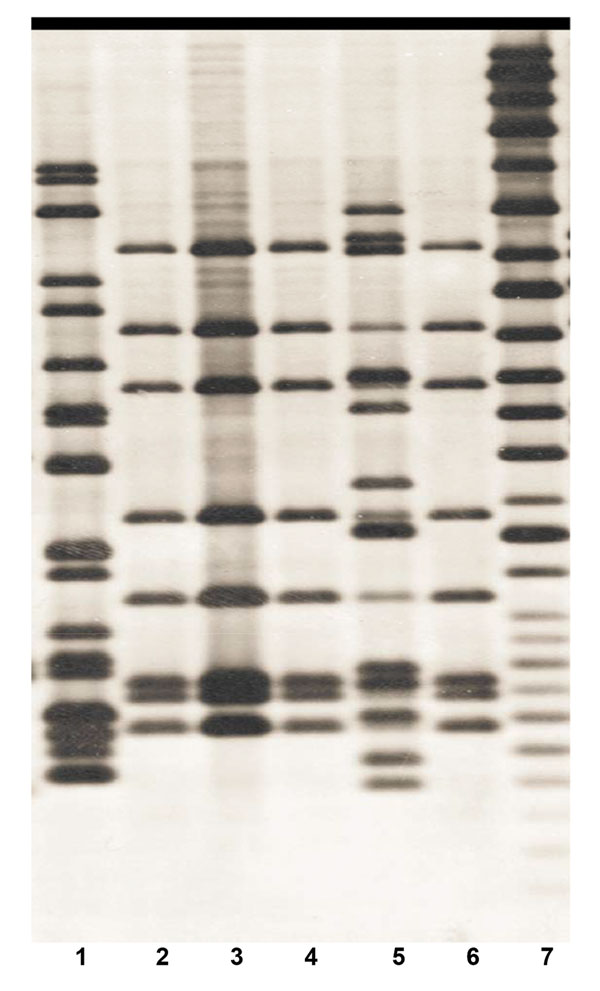Volume 23, Number 3—March 2017
Dispatch
Mycobacterium tuberculosis Infection among Asian Elephants in Captivity
Figure 1

Figure 1. IS6110 Southern blot hybridization patterns of 6 Mycobacterium tuberculosis isolates recovered from elephants A (lanes 1–5) and C (lane 6) (4) in study of tuberculosis in captive elephants, Albuquerque, New Mexico, USA, 1997–2013. The fingerprint pattern in lane 1 types the strain to principal genetic group 1, the fingerprint pattern in lanes 2–4 and lane 6 types the strain to principal genetic group 2 and the fingerprint pattern in lane 5 types the strain to principal genetic group 3. Lane 7, molecular mass standard.
References
- Mikota SK, Peddie L, Peddie J, Isaza R, Dunker F, West G, et al. Epidemiology and diagnosis of Mycobacterium tuberculosis in captive Asian elephants (Elephas maximus). J Zoo Wildl Med. 2001;32:1–16. https://dx.doi.org/10.1638/1042-7260(2001)032[0001:EADOMT]2.0.CO;2PubMedGoogle Scholar
- Animal and Plant Health Inspection Service. Guidelines for the control of tuberculosis in elephants [cited 2012 April 20]. http://www.usaha.org/Portals/6/Committees/tuberculosis/TB%20Guidelines%202012%20Draft%20revision%2020April2012.pdf
- Bifani P, Mathema B, Campo M, Moghazeh S, Nivin B, Shashkina E, et al. Molecular identification of streptomycin monoresistant Mycobacterium tuberculosis related to multidrug-resistant W strain. Emerg Infect Dis. 2001;7:842–8. DOIPubMedGoogle Scholar
- Gutacker MM, Smoot JC, Migliaccio CA, Ricklefs SM, Hua S, Cousins DV, et al. Genome-wide analysis of synonymous single nucleotide polymorphisms in Mycobacterium tuberculosis complex organisms: resolution of genetic relationships among closely related microbial strains. Genetics. 2002;162:1533–43.PubMedGoogle Scholar
- Bemer P, Palicova F, Rüsch-Gerdes S, Drugeon HB, Pfyffer GE. Multicenter evaluation of fully automated BACTEC Mycobacteria Growth Indicator Tube 960 system for susceptibility testing of Mycobacterium tuberculosis. J Clin Microbiol. 2002;40:150–4. DOIPubMedGoogle Scholar
- Zhu M, Maslow JN, Mikota SK, Isaza R, Dunker F, Riddle H, et al. Population pharmacokinetics of pyrazinamide in elephants. J Vet Pharmacol Ther. 2005;28:403–9. DOIPubMedGoogle Scholar
- Lyashchenko KP, Greenwald R, Esfandiari J, Olsen JH, Ball R, Dumonceaux G, et al. Tuberculosis in elephants: antibody responses to defined antigens of Mycobacterium tuberculosis, potential for early diagnosis, and monitoring of treatment. Clin Vaccine Immunol. 2006;13:722–32. DOIPubMedGoogle Scholar
- Michalak K, Austin C, Diesel S, Bacon MJ, Zimmerman P, Maslow JN. Mycobacterium tuberculosis infection as a zoonotic disease: transmission between humans and elephants. Emerg Infect Dis. 1998;4:283–7. DOIPubMedGoogle Scholar
- National Tuberculosis Controllers Association; Centers for Disease Control and Prevention (CDC). Guidelines for the investigation of contacts of persons with infectious tuberculosis. Recommendations from the National Tuberculosis Controllers Association and CDC. MMWR Recomm Rep. 2005;54(RR-15):1–47.PubMedGoogle Scholar
- Bryant JM, Harris SR, Parkhill J, Dawson R, Diacon AH, van Helden P, et al. Whole-genome sequencing to establish relapse or re-infection with Mycobacterium tuberculosis: a retrospective observational study. Lancet Respir Med. 2013;1:786–92. DOIPubMedGoogle Scholar
- Ford CB, Lin PL, Chase MR, Shah RR, Iartchouk O, Galagan J, et al. Use of whole genome sequencing to estimate the mutation rate of Mycobacterium tuberculosis during latent infection. Nat Genet. 2011;43:482–6. DOIPubMedGoogle Scholar
Page created: March 10, 2017
Page updated: March 10, 2017
Page reviewed: March 10, 2017
The conclusions, findings, and opinions expressed by authors contributing to this journal do not necessarily reflect the official position of the U.S. Department of Health and Human Services, the Public Health Service, the Centers for Disease Control and Prevention, or the authors' affiliated institutions. Use of trade names is for identification only and does not imply endorsement by any of the groups named above.